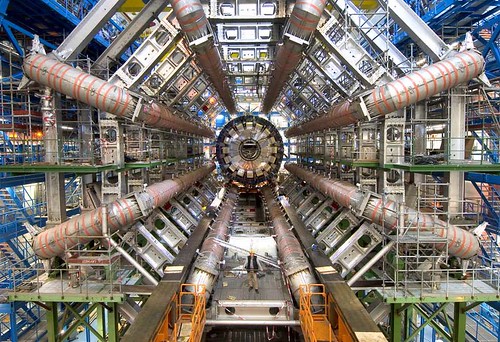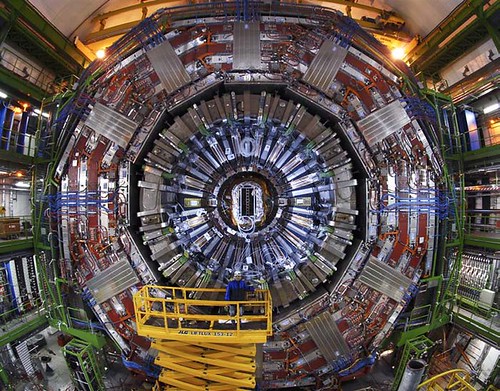What the Higgs are you talking about?
- By Umberto Cannella
- September 21, 2012
- Comments Off on What the Higgs are you talking about?
It’s been a little while since the big announcement has been made: two experiments at CERN have discovered a new fundamental particle of Nature, one that very much resembles the famous Higgs Boson, also known as the God particle.

A view of the ATLAS experiment at CERN: the level of complexity and the size of the machine are apparent when compared with the human scale. Credit: CERN
The day before the announcement I was so excited that I thought about staying up all night in order to follow the event scheduled at 9am Central European Time. I finally changed my mind and went to sleep but when I got up and watched the news from Geneva the excitement came back. This time it was accompanied by joy, surprise and a sense of fascination: those where the feelings that mixed inside me as I was confronted with another piece of Nature’s works of art, which is unveiled for our eyes and brains to contemplate. I cannot claim I was as anxiously curious about the Higgs hysteria as Professor Higgs himself, who was moved to tears when watching the experimental results that were telling him and the world: “There it is!” I am not as wise and expert as Professor Higgs nor this is the field of research I have investigated most closely. However it is not because of how much physics I know that I felt personally touched by all this. The fact that many so-called laymen people got interested and non-scientific websites and newspapers keep talking about it tells me that mankind have strong feelings for what is fundamental. Basic principles have an intrinsic charm: they are those concepts which are necessary to explain a lot of other things in a simple, general and elegant manner. They put order in chaos and enable a wider and richer viewpoint. Nailing one more of these basic principles makes us more conscious of the natural reality we inhabit and, thus, can only make us feel more deeply human.
But what exactly is this “Higgs principle” about? You could call it “the principle of mass” because of the role the Higgs field has in the Standard Model: in this theory of elementary particles and fields a mechanism is needed to explain why elementary particles exhibit mass as one of their characterizing properties. This is not a minor issue to settle: until the announcement by CERN on July 4, we had an impressive theoretical construct, which had received extremely accurate experimental confirmation but needed one last cornerstone to be fully sustained. To better understand this situation we can draw a comparison between the state of the Standard Model until July 4 and a very intriguing well written novel: you cannot abandon the book before you read the final chapter, it does not make sense, you have to know how the story ends, otherwise all what you have read so far is meaningless. So was proving the existence of the Higgs field through detecting one of its excitations, the Higgs Boson particle: without “the principle of mass” being exposed we could not have claimed to have a satisfying theory that explains the high energy phenomena we have observed so far.

Professor Peter Higgs holding a stuffed Higgs boson
Credit: Jennifer Harding-Edgar from Edinburgh
We can now make sense of mass in our theory of elementary particles and fields by a sort of invisible sea, the Higgs field: every elementary particle is a type of fish in this sea and its mass is a consequence of how much the water slows it down; this image phrases the more technical terminology of mass resulting from how strongly a peculiar particle species interacts with the Higgs field. Without the Higgs field all particles would have zero mass and, thus, would all move at the speed of light; moreover, the interactions among particles would be different. As a consequence, it would be impossible to form atoms. But no atoms means no galaxies, no stars, no planets, no us. The reason why, instead, we are here is because today the universe is beautiful but not elegant: as a matter of fact the Universe used to be much more mathematically elegant when it was just born. In its very first moments of life the Universe was so simple and symmetric that particles did not distinguish themselves because of mass and there were not even as many types of forces as we see today. The Higgs field was not there, not yet; at some point, in a way we do not yet master, it came into existence because an equilibrium (a symmetry) broke. Thanks to this messy run toward the present “un-elegance,” the Universe was now more prepared to grant the physical conditions that later (much later) would bring to our existence.
Nice and intriguing, huh, but how is this important for our everyday life? In another Blueshift post of mine I had the chance to talk a bit about the misnomer fundamental research has to be detached from our current needs. Let me borrow from that excerpt the counter-example I love the most. The experimental apparatus in Europe that has enabled the new discovery of the Higgs Boson is called LHC, which stands for “Large Hadron Collider”: this is fancy talk to say that the underground laboratory at the border between France and Switzerland is a sort of humongous dodgem where smashing cars are minuscule particles of a category known as “hadrons.” I hope you are not familiar with this particle category by personal experience but hadrons play a crucial role in one of the most accurate cures for tumors we have, hadron-therapy: who else could have possibly revealed the existence and behavior of hadrons if not those grown-ups who have kept their curiosity intact since the time they were kids?

A view of the CMS experiment at CERN: when you see it in person you have the impression of being in front of an alien spaceship from the future. Credit: CERN


